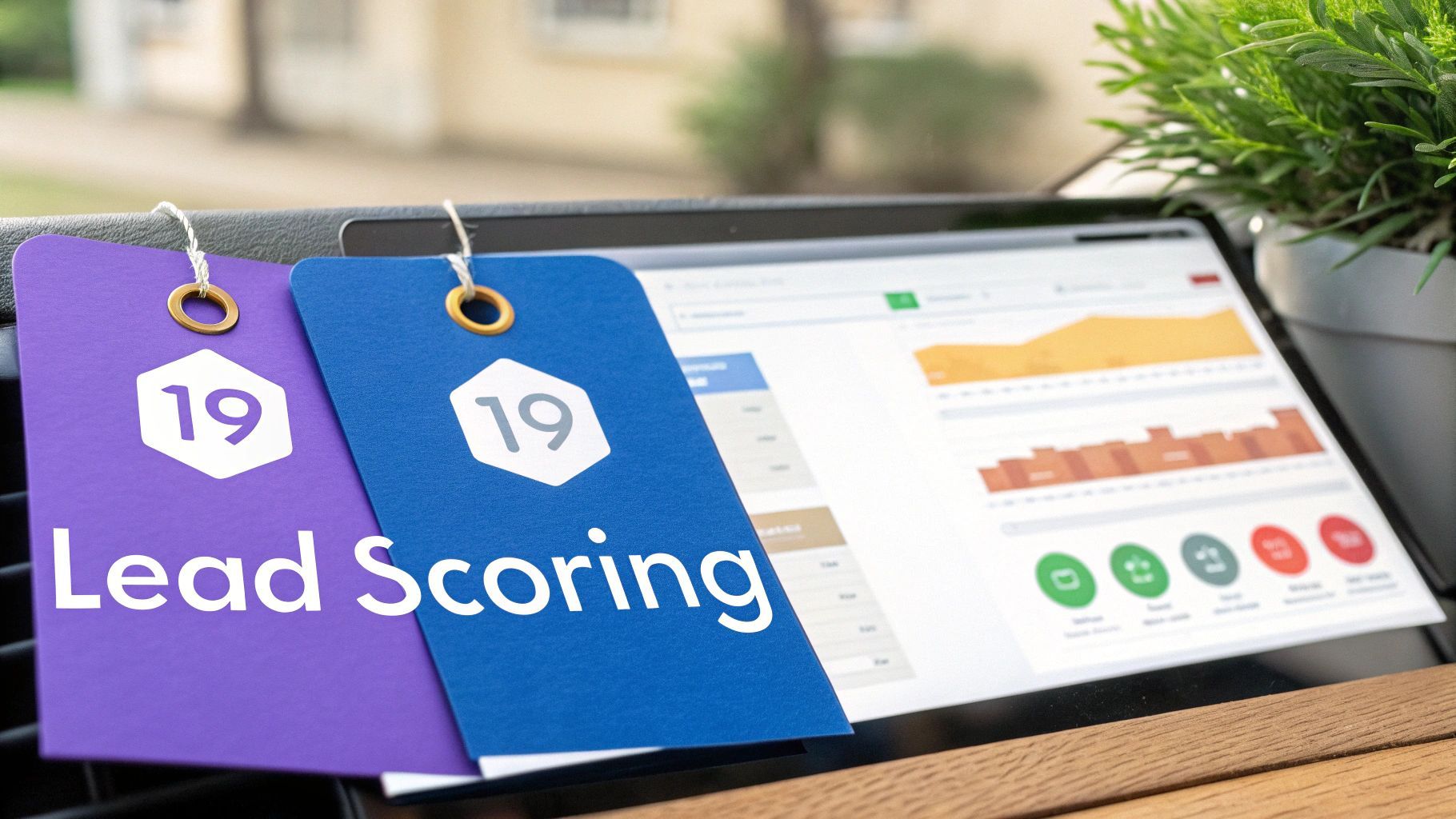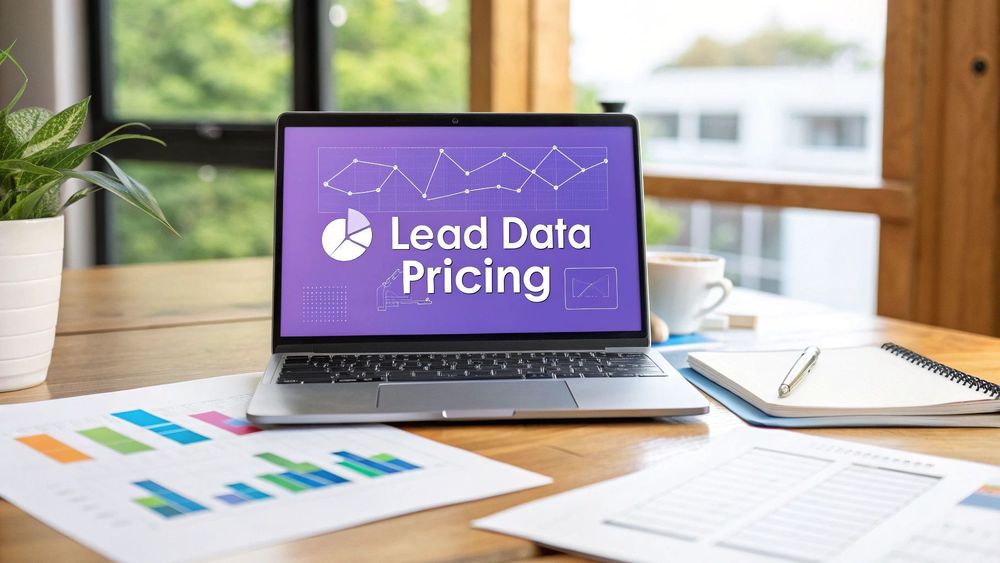If you want to charge premium rates for your contact lists, you have to stop selling a commodity and start delivering a strategic asset. It's a fundamental shift in thinking. You're no longer just slinging a spreadsheet of names; you're providing a high-quality, enriched, and perfectly segmented database that your clients can plug directly into their sales and marketing efforts to make money.
The secret? It's all about data quality over quantity. And, more importantly, proving that superior value.
Why Your Generic Contact Lists Are Worthless
Let’s be brutally honest for a second. Most contact lists are commodities, plain and simple.
They’re slapped together from public sources or, worse, ancient databases. This means they're cheap to make and even cheaper to sell. If your whole business model is based on selling these basic lists, you're in a race to the bottom on price, and you'll never win.
This approach creates a vicious cycle of low value for everyone. Your clients buy these lists and immediately run into sky-high bounce rates, abysmal engagement, and sales teams wasting their time. What does this teach them? It teaches them that contact lists aren't worth paying a premium for, locking you into that commodity mindset.
The Problem with Low-Quality Data
A generic list doesn't just fail to deliver—it can actively hurt a client's brand and burn through their resources. The problems are always the same:
- Outdated Information: People change jobs. Companies get acquired. Emails go defunct. A list that's just six months old can have a data decay rate of over 15-20%. It becomes useless fast.
- Incomplete Profiles: A name and a company just don't cut it anymore. Without direct dials, social profiles, or any real context, your client's outreach is dead on arrival.
- Lack of Relevance: Handing a client a massive, untargeted list is like telling them to find a needle in a haystack. It forces their team to spend hours sifting through thousands of contacts that are a terrible fit.
A premium list isn’t just a collection of contacts; it's a curated set of pre-qualified opportunities. This fundamental shift from data provider to opportunity provider is what allows you to break free from commodity pricing and charge what you're truly worth.
Before we go deeper, let's just lay out the difference between what most people sell and what you should be selling.
Standard vs Premium List Value Comparison
| Attribute | Standard List (Low Value) | Premium List (High Value) |
|---|---|---|
| Data Source | Scraped from public sources, often old | Multi-source verified, recently updated |
| Accuracy | High bounce rates (10%+) | Low bounce rates (< 3%), verified contacts |
| Enrichment | Name, company, maybe a generic email | Direct dials, social profiles, tech stack, buying signals |
| Segmentation | Broad industry or job title | Hyper-specific ICP, custom-built for the client |
| Client Effort | High - requires manual filtering and research | Low - ready for immediate outreach |
| Typical Outcome | Low engagement, wasted resources | Higher connection rates, qualified meetings |
See the difference? One is a chore; the other is a solution.
To command premium rates, you have to deliver a product that solves all the problems on the left side of that table. Your data needs to be accurate, comprehensive, and perfectly dialed into your client's ideal customer profile.
You're not just selling a file of names anymore. You're selling a real business outcome—more qualified meetings and higher connection rates. Building a list like this starts with the right approach, and mastering some advanced niche list building strategies is the perfect first step. This strategic shift is the foundation for getting clients to happily pay a premium, time and time again.
Build Your Foundation with Hyper-Targeted Prospecting
If you want to charge premium rates, the old "spray and pray" method has to go. It's a relic. A premium list isn't built with a wide net; it’s built with surgical precision right from the start.
I remember the old way all too well. It meant spending hours—sometimes days—manually clicking through LinkedIn profiles, digging through company directories, and scraping industry websites. It was slow, tedious work, and honestly, it was always riddled with errors.
The modern workflow is all about speed and accuracy from the get-go. It's about starting with a group of prospects so perfectly aligned with your ideal customer that the list is inherently valuable before you even add a single piece of enrichment data. This is exactly where a no-code profile scraper becomes your most valuable player.
Moving From Manual Labor to One-Click Precision
Let's walk through a real-world scenario. Imagine a recruiter needs to source an entire engineering team from a competitor’s website. The manual way? Clicking each profile, copying their name, title, and social links, then pasting it all into a spreadsheet. That’s an entire afternoon burned, easily.
Now, picture this instead: The recruiter lands on that same team page, opens the ProfileSpider extension, and hits "Extract Profiles." In seconds, every single engineer's profile is captured and dropped neatly into a new list. This isn't just about saving time; it's a fundamental change in how you build high-value contact lists. This initial, precise targeting is the bedrock of a premium data asset. To really nail this, you also need solid strategies on how to build an email list from the ground up.
The infographic below really drives home this shift—moving from a generic, bloated list to a premium one, where quality targeting is the first and most critical step.

This shows that the whole process starts with a deliberate focus on quality, which is only possible through precise initial prospecting.
Building Your Ideal Cohort at Scale
This same principle holds true for sales pros. Think about a sales rep who wants to target every speaker from a virtual conference's public agenda page. Instead of mind-numbing manual data entry, they can pull every speaker's details with a single click.
With ProfileSpider, you can then use bulk actions to instantly organize these newly extracted profiles. Just select all and move them into a dedicated list, keeping everything streamlined from the very beginning.
The most valuable lists are never the biggest; they are always the most relevant. Starting with a hyper-targeted group cuts through the noise and ensures every subsequent action—like data enrichment—is spent on a prospect who is already a fantastic fit.
This foundational precision is simply non-negotiable. Whether you're in recruiting, marketing, or sales, your ability to justify and charge premium rates is directly tied to the relevance of your initial prospects.
For a deeper dive into these methods, our guide on prospecting on LinkedIn offers more actionable techniques. By using an AI profile extraction tool, you build a foundation of pure quality that justifies a higher price tag from day one.
Turn Contacts into Comprehensive Profiles with Data Enrichment
A list of names and companies is just a starting point. It’s a low-value commodity, honestly. The real, tangible value—the kind that lets you increase list value and charge premium rates—is buried in the details.
A simple contact transforms into a high-value asset when it becomes a comprehensive professional profile.
Think about it: what’s more powerful for a sales team? A spreadsheet with 100 company names, or a list of 100 key decision-makers with their direct-dial phone numbers, verified corporate emails, and active LinkedIn profiles? The second list isn’t just better; it’s an entirely different product. It's a ready-to-use outreach tool, and clients will absolutely pay a premium for that advantage.
This process of adding the missing details is called data enrichment.

The Old Way: Manual Research Grinds You Down
Traditionally, enriching a list was a soul-crushing, manual task. I’ve been there. For every single contact, you’d have to:
- Open a dozen browser tabs.
- Hunt for their LinkedIn profile.
- Scour company websites for an email format.
- Use other tools to guess at a phone number.
This painstaking process could take anywhere from 5 to 15 minutes per contact. Do the math. For a list of just 100 people, that’s over 16 hours of tedious, mind-numbing work. This manual bottleneck makes it nearly impossible to build and sell premium lists at any real scale.
From Hours to a Single Click with AI Enrichment
This is where modern tools completely change the game. Instead of that manual drudgery, you can automate the entire enrichment process. With a no-code scraping tool like ProfileSpider, this complex workflow gets boiled down to a single click.
Let's walk through a real-world scenario. A marketer just used ProfileSpider to pull a list of 100 speakers from an upcoming industry conference website. The initial scrape gives them names, companies, and a link to their speaker bio page. It's useful, but it's not a premium asset yet.
To level this list up, the marketer simply selects all 100 profiles and clicks the “Enrich” button.
That's it. ProfileSpider’s AI engine then gets to work, visiting each speaker's bio URL in the background to find and pull all the missing details. Within minutes, the list is automatically populated with:
- Verified work emails
- Direct phone numbers
- Links to LinkedIn and Twitter profiles
- Updated job titles and locations
This one-click action transforms a basic directory into a powerful outreach database. The marketer didn't spend hours searching; they spent seconds clicking a button. This is the core of a scalable, high-value data business.
By instantly adding these crucial layers of contact information, you’re not just saving your client time—you’re giving them direct access to their target audience. This is the kind of undeniable value that makes justifying premium rates easy. You’re no longer selling raw data; you’re selling speed, accuracy, and opportunity.
Turn Your List into a Precision Tool with Smart Segmentation
An enriched list is a great start, but a segmented list? That's a whole different ballgame. It's where you really start adding massive value.
Think about it. Handing over a giant, flat spreadsheet of high-quality contacts is better than nothing, but you're still making your client do all the heavy lifting. The real magic—and the justification for premium pricing—happens when you transform that raw file into an organized, searchable, and instantly usable asset.
Segmentation is simply the art of slicing and dicing your list based on the criteria your client actually cares about. It’s the move from just providing data to delivering genuine intelligence. This single step is what separates the commodity data sellers from the high-value strategic partners.
From Raw Data to a Tailored Solution
Let’s be honest, your clients don’t just want "leads." They want a very specific kind of lead. A sales team doesn't just need a list; they need a list of, say, ‘VPs of Marketing at SaaS companies with under 500 employees, all based in North America.’
Imagine trying to build that list manually. You’d be stuck in a spreadsheet nightmare, filtering, cross-referencing columns, and praying you don't mess something up. It's tedious, slow, and prone to error.
This is exactly where a modern tool’s organizational power shines. With something like ProfileSpider, you can go way beyond a simple data dump. Its built-in contact management system becomes your command center for crafting these hyper-targeted datasets.
- Build Custom Lists: Group profiles by project, campaign, or client. You can create distinct lists like "SaaS Decision-Makers," "Q4 Event Speakers," or "Competitor Talent Pool."
- Layer on Contextual Tags: Tags add another dimension for filtering. You might tag contacts as ‘decision-maker,’ ‘influencer,’ or ‘past-client’ to quickly pull up key groups.
- Add Crucial Notes: Drop in specific notes for vital context. Things like "Met at HubSpot conference" or "Expressed interest in AI tools" can be gold for a sales rep.
When you deliver a precisely segmented list that perfectly mirrors your client's ideal customer profile, you're not just selling data. You're selling them a shortcut to revenue. That's a service that will always command a premium.
A Real-World Segmentation Workflow
Picture a recruiter who's been tasked with sourcing candidates for three different roles: a Senior Developer, a Product Manager, and a Sales Director.
Instead of just sending over one massive, jumbled list, they can use ProfileSpider to create three clean, organized talent pools. They’d start by gathering relevant profiles from places like LinkedIn or industry job boards. Then, right inside the tool, they'd create three separate lists: "Dev Candidates," "PM Candidates," and "Sales Candidates." As new profiles come in, they get sorted into the right bucket immediately.
But they can take it a step further. They can add tags like ‘frontend-specialist,’ ‘B2B-SaaS-experience,’ or ‘enterprise-sales’ to each profile. This kind of granular detail means the recruiter can instantly find the perfect candidates for any hiring manager's specific request.
This isn't just a list anymore. It’s a dynamic talent pipeline, and that has immense, undeniable value.
Prove Your List's Superiority with Lead Scoring
You've done the hard work of enriching and asegmenting your list. So, how do you actually prove it's worth a premium price tag? You need a number that screams quality. That number is a lead score. This is the key to shifting your offer from a simple contact list to a package of pre-qualified, high-intent opportunities.
Think about it. Lead scoring is just a straightforward way to assign points to contacts based on the attributes you know your clients find valuable. Instead of vaguely saying a list is "good," you can confidently tell a client, "This list includes 50 Tier-1 leads, each scoring 90 or higher."
That’s a powerful, tangible statement that instantly backs up your pricing. You’re no longer just selling raw data; you're selling results.

Building a Simple Scoring Model
You don't need some complex, expensive software for this. A powerful scoring system can be built right inside a tool like ProfileSpider using its tagging and notes features. The whole game is about defining what makes a lead valuable to your specific client.
Start by mapping out a simple points system based on the key data points you've gathered. Here’s an example of what that might look like:
- +20 points for a C-level or VP title.
- +15 points for a verified direct-dial phone number.
- +15 points for a complete LinkedIn profile URL.
- +10 points for working at a company in a target industry (like SaaS).
- +10 points for a recent job change noted on their profile.
Suddenly, abstract quality becomes a concrete, sellable number.
Applying Scores and Making Value Visible
Once your model is set, the process is dead simple. Go through each profile on your list, tally up the points based on your criteria, and then use ProfileSpider’s features to make that score pop.
You can add a note to each profile with their total (e.g., "Score: 85"). Even better, use tags to create tiers. A contact scoring 80+ gets a "Tier-1" or "Hot Lead" tag. Anyone in the 60-79 range could be labeled "Tier-2."
By assigning a clear score and tier to every single contact, you turn a subjective asset into an objective one. You're handing your client a data-backed reason to pay more. It's the ultimate proof of quality.
This simple act of scoring completely elevates your offering. When you use lead scoring to pinpoint your most valuable prospects, you can then build sophisticated campaign optimization strategies around them to drive incredible conversion rates and show off the true power of your list.
You're no longer just providing data. You're providing a strategic roadmap to your client's next customer—and that's a service that will always command a premium.
How to Package and Price Your Premium Data
You've done the hard work. You've built the list, enriched the contacts, and segmented everything just right. Now comes the fun part: turning that asset into actual revenue.
This is where the rubber meets the road. How you package and price your data is just as critical as the quality of the data itself.
You’re not just selling a spreadsheet anymore. You’re offering a CRM-ready, strategic toolkit that’s built for immediate action and real results. Making this mental shift is exactly what allows you to confidently increase your list value and charge a premium.
Crafting Your Pricing Tiers
Forget one-size-fits-all pricing. It rarely works for high-value data. A much better approach is to build a tiered pricing model that ties the cost directly to the value a client receives. This gives them options and helps you land deals across a wider range of budgets.
Here are a few models I’ve seen work wonders:
- Per-Record Pricing: This is the classic, straightforward model, but with a twist. You still charge a flat fee per contact, but you create tiers based on how deep the enrichment goes. A basic profile (name, company, title) sits at one price point. A fully enriched profile with a verified email and a direct-dial number? That commands a much higher rate.
- Subscription Access: Perfect for clients who need a constant stream of fresh contacts. Think monthly or quarterly subscriptions. This model is a goldmine when you're regularly updating a dynamic list, like "newly appointed VPs of Sales in the tech industry."
- Package Deals: Bundle your segmented lists into laser-focused packages. For instance, you could sell a "SaaS Startup Founder Outreach Kit" that includes 200 fully enriched profiles of founders from companies that just closed a funding round.
The real secret is to frame your pricing around the outcome. Stop selling "100 contacts." Start selling "100 pre-qualified, C-level decision-makers in the finance sector, complete with direct contact information." When you use value-based language like that, a premium price tag feels less like a cost and more like a smart investment.
Delivering a Professional Product
The final delivery is what seals the deal and reinforces your premium brand. Sending over a messy CSV file completely undermines all the effort you've put in.
This is where a tool like ProfileSpider becomes indispensable. Its clean export options mean you can deliver a professional, CRM-ready product that instantly justifies the price.
When a client opens a neatly organized CSV or Excel file—with columns perfectly mapped and data ready for immediate import—it just screams professionalism. It shows you get their workflow and you respect their time. This seamless handoff is the final, powerful proof point that solidifies your premium rates.
For a deeper dive, check out our guide on creating a pricing model for your lead data business. It’s this attention to the final detail that will cement your reputation as a provider of truly high-value data.
Got Questions? We've Got Answers
You're not alone in wondering how to turn a good list into a high-ticket asset. Here are some of the most common questions that come up when people are trying to level up their list-building game.
How Do I Convince a New Client to Pay More for My List?
It all comes down to shifting the conversation from quantity to quality. You're not just selling a spreadsheet of 100 names. You're delivering 100 pre-qualified, fully-enriched profiles of C-level decision-makers in the SaaS industry. See the difference?
Your best friend here is tangible proof. Use lead scoring to create clear tiers like 'Tier-1' or 'Hot Leads' so clients can see the objective value.
When you bring in a tool like ProfileSpider, you can instantly arm your list with direct dials, verified emails, and social links. What was once a simple contact sheet is now a powerful outreach asset. You're no longer selling raw data; you're selling your client a direct shortcut to qualified meetings and sky-high connection rates. That's an investment that's easy for any smart business to justify.
Should I Sell One-Off Lists or Offer a Subscription?
Honestly, this depends entirely on your client's needs and how you want to structure your business. There's no single right answer, but here's how I see it.
One-off lists are perfect for clients with a very specific, time-sensitive project. Think targeting attendees of a major conference or hitting a niche group for a product launch. You can charge a serious premium for these hyper-targeted, ready-to-use datasets because you're solving an immediate, high-value problem.
A subscription model is where you build a long-term, strategic relationship. Instead of a one-time vendor, you become their go-to partner for intelligence. Imagine offering a client a fresh, updated list of "newly appointed VPs of Marketing" every single month. That kind of dynamic data is incredibly valuable. It’s more work on your end, for sure, but it creates predictable, recurring revenue and makes you indispensable.
How Does ProfileSpider Actually Boost the Value of My Lists?
ProfileSpider is built from the ground up to add serious value at every single step of the process. It's not just a scraper; it's a value-add machine.
Here’s how it works in practice:
- Pinpoint Targeting: It lets you get incredibly specific right from the start. No more sifting through junk leads. You begin with a high-quality, relevant list from day one.
- Instant Enrichment: The one-click "Enrich" feature is where the magic really happens. It fills in all those crucial data gaps—emails, phone numbers, social profiles—which is the number one thing that lets you command premium prices.
- Smart Organization: Its built-in contact management features let you segment your lists and add custom tags. You’re not just handing over a flat file; you’re delivering a custom-built, organized database that your clients can actually use.
By automating the most tedious, time-sucking parts of list building, ProfileSpider frees you up to focus on the strategy and quality that truly justifies those top-tier rates.




